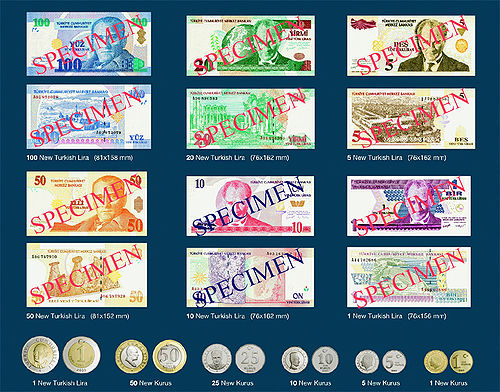Coins of Turkey
This article concerns the coins of Turkey.
In 1922/23, a new coinage was introduced consisting of aluminium-bronze 2.5, 5 and 10 kuruş and nickel 25 kuruş. They were last issued in 1928. These were the last Turkish coins to bear inscriptions in the Arabic script.
In 1934, silver 1 lira coins were struck, followed the next year by a new coinage consisting of cupro-nickel 1, 5 and 10 kuruş, and silver 25 and 50 kuruş and 1 Turkish lira. Aluminium-bronze 0.25 kuruş coins were issued between 1940 and 1942, the last coins to bear this denomination. Nickel-brass replaced silver in the 25 kuruş in 1944, with brass 1, 2½, 5, 10 and 25 kuruş introduced between 1947 and 1949. The silver 50 kuruş and 1 Turkish lira were discontinued in 1948, with cupro-nickel 1 Turkish lira issued in 1957.
Between 1958 and 1963, bronze 1, 5 and 10 kuruş and steel 25 kuruş, 1 and 2½ Turkish lira were introduced, followed by steel 50 kuruş and 5 Turkish lira in 1971 and 1974, respectively. Aluminium replaced bronze in 1975. These coins were issued up to 1980.
In 1981, with inflation gaining pace, aluminium 1, 5 and 10 Turkish lira coins were introduced. Higher denominations followed: 20, 50 and 100 Turkish lira in 1984, 25 Turkish lira in 1985, 500 Turkish lira in 1988, 1000 Turkish lira in 1990, 2500 Turkish lira in 1991, 5000 Turkish lira in 1992, 10,000 Turkish lira in 1994, 25,000 Turkish lira in 1995, 50,000 Turkish lira in 1997, and 100,000 Turkish lira in 1999. This culminated in 250,000 Turkish lira coins in 2002.
In the transitional period between 1 January 2005 and 31 December 2008, the second Turkish lira was officially called "new Turkish lira" in Turkey. Coins were introduced in 2005 in denominations of 1, 5, 10, 25 and 50 new (yeni) kuruş and 1 new (yeni) Turkish lira. The 1 new kuruş was minted in brass and the 5, 10 and 25 new kuruş in cupro-nickel, whilst the 50 new kuruş and 1 new Turkish lira are bimetallic. All coins show portraits of Mustafa Kemal Atatürk.
To the dismay of the European Central Bank, the sizes and compositions of the 50 new kuruş and 1 new Turkish lira coins clearly resemble those of the €1 and €2 coins respectively. (See comparison photo in [1] of YTL 1 coin and €2 coin.) This could cause confusion in the eurozone. It also caused trouble to businesses using vending machines (particularly at airports) in the eurozone since a number of vending machines at the time accepted the 1 new Turkish lira coin as a €2 coin. Since €2 is worth roughly four times more, vending machines affected had to be upgraded at the expense of their owners.
...
Wikipedia

